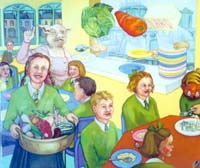
§ Home § Search § SoupTales § Any comments?
Graveyard Soup
(as eaten by a large English family in the 1950s)

Not to be confused with "Post War Plenty" soup--pictured here in an oil canvas by English artist and sculptor Judith Forrest (now living in Australia)--quite the reverse of her story about the family Graveyard Soup, made and served at home in the lean years just following World War II. Her recipe and story, below, reveal a fascinating slice of history, culture, and family life in a particular time and at a particular place. Mr. Bailey the butcher, for example, walks right out of the pages of distinctively British humor. To see more of Judith's work, go to http://www.optusnet.com.au/~lucjudith or just click on the picture.
- Send smallest, cutest child to the butcher for "Bones for the Dog." If child is really lucky, parents' wishes will be thwarted and it will not be a sheep's head or a calf's heel...but probably it will be one or the other.
- Swear cute child to secrecy (i.e., exactly which nasty bones have been secured from the butcher) and place bones in bottom of a large pot together with any dried beans, halved onions, carrots, potatos, left overs etc. available. N.B.: nothing should be peeled, "Peel's good for you." No salt (Salt's bad for you).
- Boil for a long time until all the gelatin is extracted from around the bones and brown scum appears on the surface. Remove scum. Make room for the cabbage cut into quarters.
- Serve up and strongly deny the existence of bones at bottom of pot. Fussy diners (i.e., children) are advised not to dig too deep...hence the name Graveyard Soup.
* * * "I don't know quite what to tell you, except that this is what my mother fed us on, during winter, for most of my childhood. She hated to cook but had definite beliefs about what was good for us. Green vegetables were only cooked until hot, and were always very crisp and not soft. She could not be bothered to cut, grate, shred, peel or stir food so meals were planned around these basic principles. Her other staple was baked potatoes together with fried onions and four penny bacon (bacon off cuts).
"Mr. Bailey the butcher was much feared by me as he gave the older children chicken legs to play with (he showed them how to pull the tendons to make the leg jump) and he once put my doll on the chopping block and pretended to cut her leg off.
"I think "Bones for the dog" was a euphemism a bit like asking for a doggy bag in a restaurant today and that every one asked for these for their own use. In any case after the doll incident, I did not have to go to the butcher. We had dogs and they did get the bones in the end so my mother would not have thought it a lie to ask for them this way.
"As for Graveyard Soup itself, I think it was probably my brother who named the dish. Certainly, I still refer to any soup containing bones as graveyard soup and, though I have not seen them for ages, I'm sure my sisters do too. The food we ate was nutritious but not great. My mother was very resourceful and what little money she saved on food, etc., she spent on books and travel which, unusually for parents of that time, she thought much more important than homemaking skills."